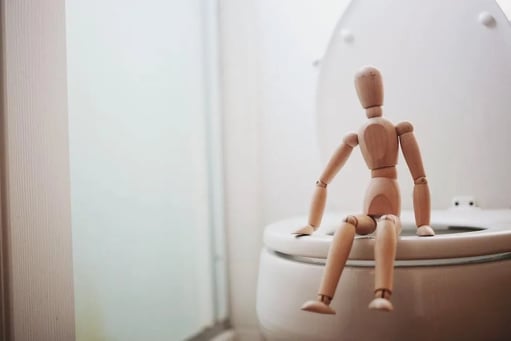4 min read
Tips On How To Stop a Toilet From Constantly Running
![]() David Schwartz
Oct 19, 2023 5:53:06 PM
David Schwartz
Oct 19, 2023 5:53:06 PM

Tired of wasting money on water expenses because your tenants’ toilets keep running? Luckily, you don’t need to call a plumber yet — depending on the problem, it might be a simple DIY fix.
You can’t ignore a running toilet; it wastes gallons of water and won’t fix itself. One toilet that keeps running is terrible enough, but if you own multiple rental properties, who knows how much you’re paying for water no one uses?
We’ll help you determine the cause of your running toilet, find the problem, and get it working again.
Related: How to Reduce Tenant Water Bills
Why Is Your Toilet Running?
Usually, a toilet that won’t stop running is caused by a problem with one of the three parts in its tank: The overflow tube, flush valve, or fill valve.
If a toilet is running constantly, it’s because either water is passing continuously through its flush valve flapper or the water in the tank keeps flowing into the overflow tube. You can easily check where the water is running from by putting some dye in the toilet’s tank.
If the dyed water enters the toilet bowl, the problem is likely with your flush valve or flapper mechanism. However, the issue will likely be with the overflow system or fill valve if the water remains clear.
Are your tenants’ toilets running? Better go catch them — just kidding; you better install the #1 leak prevention device and stop watching your money go down the toilet.
3 Ways to Stop a Toilet From Running
You can fix most causes of a running toilet by spending a little time diagnosing the problem and replacing either the flush or fill valve, which isn’t as challenging as it sounds.
However, suppose the toilet is overflowing, or the water level in the toilet bowl rises while the water is running. In that case, we recommend turning off the water supply and calling a plumber — there could be a more significant issue.
With that said, here’s how to diagnose and stop a toilet from running.
-
Diagnose the Problem With the Overflow Tube
Let’s start by checking the overflow tube — a hollow tube connected to the toilet’s flush valve. This part is designed to prevent your tank from overflowing if the fill valve fails to turn off. Several reasons can cause your toilet to run when water runs into the overflow tube.
- First, check the water level by removing the lid on the back of the toilet. If the water level goes past the overflow tube, you need to lower it. However, if the water level is below the overflow tube, your problem likely lies with the flush valve.
- Lower the water level by adjusting the float rod/cup. A float cup wraps around the fill valve and moves with the water level, while a float rod attaches a ball to the fill valve. There should be a screw that attaches this part to the fill valve — you can lower the water level by turning it counterclockwise.
- If your water level doesn’t change with these adjustments, you have a fill valve problem. However, if the toilet stops running but no longer has enough water to flush properly, it means your overflow tube is too short, and you’ll have to replace the flush valve.
Related: The Best Solution for Leaky Toilets
-
Check and Replace the Flush Valve
A toilet’s flush valve opens the flapper to allow water to flow into the toilet when flushed and closes it to refill an empty tank. Problems with this system are among the most common causes of running toilets.
- Check the chain that connects to the flapper. If it’s too long or too short, the flapper won’t open and close properly. The chain’s length should be long enough to allow the flapper to close without any extra chain that can get trapped underneath it, causing water to leak.
- Next, look at the flapper — they can wear out or become dirty over time, causing them not to sit correctly in the flush valve seat. If it looks dirty, you can try cleaning it with vinegar and water, but if it’s not sealing because it’s warped or worn, you’ll need to replace the flush valve.
- To replace the flush valve, turn off the water to your toilet and drain the tank by flushing it. Removing the old valve consists of disconnecting the flapper, removing the bolts holding the flush valve system in place, and loosening the flush valve nut.
- After installing the new flush valve, reconnect the toilet’s water supply and test it. If the water continues to run, double-check the flapper is installed correctly.
-
Check and Replace the Fill Valve
A toilet’s fill valve controls the water flow to its tank from your main water supply. A broken fill valve will cause a toilet to run constantly as it doesn’t recognize that the tank is full and keeps trying to fill it. Replacing your toilet’s fill valve is relatively easy.
- Remove the toilet tank lid, then check the water level and overflow tube height. If the water continuously flows into the tube, but the water level is set correctly, it’s time to replace the fill valve.
- Turn off the water supply and drain the tank before removing the fill valve assembly — unscrew the nut on the bottom of the toilet’s tank and pull out the fill valve. Then, adjust the new fill valve’s height to suit your toilet tank and desired water level, insert it into the bottom of the tank, and secure it with a locking nut, creating a watertight seal.
- Reconnect the water supply and watch the tank fill up, which should happen if you installed the fill valve correctly. Now, the water level should be perfect, and the toilet should no longer be running.
Related: This Toilet Valve Solves 80% of Leaks.
Save Money on Water By Preventing Toilet Leaks
Many landlords overpay for water bills and don’t realize it. Many toilet leaks are subtle, and your tenants might not even notice them — or they don’t report the issues because they’re not the ones paying for the water.
Fortunately, there’s an easy solution to preventing running toilets and water leaks: The Toilet Scrooge leak prevention device. All you have to do to save money on your water bills each month is tie it to your water line.
Our leak prevention valve only allows water to flow to the toilet when someone is present, as indicated by its built-in motion sensor. Plus, the entire device is powered by water; there’s no battery maintenance or energy usage to worry about — installation takes minutes, and upkeep is almost nonexistent.
Stop wasting money paying for water your tenants aren’t even using. Start saving with the Water Scrooge — we help landlords save significantly on their water expenses.

